Rio Tinto Bundle
Who Buys Billions from Rio Tinto?
In the vast and vital Rio Tinto SWOT Analysis, understanding customer demographics and the target market is crucial for a mining giant like Rio Tinto. With a legacy spanning over a century, Rio Tinto's success hinges on knowing precisely who its customers are and how to meet their evolving needs. This deep dive explores the intricacies of Rio Tinto's customer base, offering insights into their geographic locations, buying behaviors, and the company's strategic adaptations.
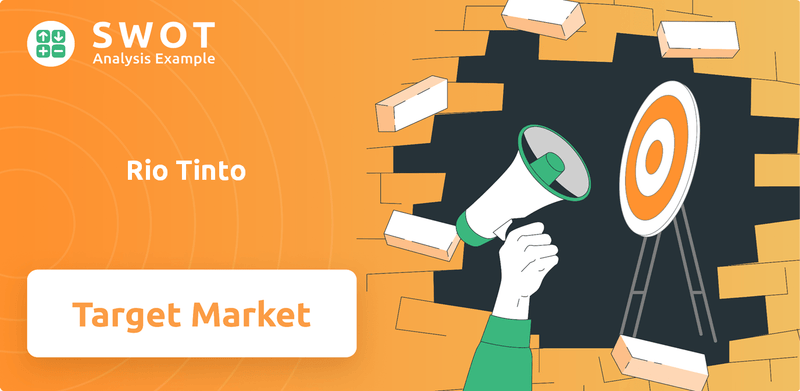
From iron ore to aluminum, Rio Tinto's product offerings cater to a diverse range of industries, making a thorough market analysis essential. This exploration will delve into Rio Tinto's key customer segments, providing a detailed customer profile analysis to understand their needs and wants. We'll also examine how Rio Tinto identifies its target market and its customer relationship management strategies, ensuring a comprehensive view of this industry leader's approach to its Rio Tinto target market and Rio Tinto customer demographics within the competitive mining industry.
Who Are Rio Tinto’s Main Customers?
Understanding the customer demographics and target market of the company is crucial for grasping its business model. The company operates primarily in the business-to-business (B2B) sector, focusing on supplying raw materials to various industries. This positions the company as a key player in the global supply chain, serving large industrial manufacturers and processors.
The company's target market is composed of industrial manufacturers that use its mined resources. Key segments include steel producers, automotive, aerospace, and construction industries. The company also supplies high-value minerals like diamonds and specialty products such as borates and titanium dioxide.
A detailed market analysis reveals that the company's customer base is geographically diverse, with significant sales in Greater China and other regions worldwide. This highlights the company's global reach and the importance of understanding regional market dynamics.
The main customer groups include steel producers, automotive manufacturers, aerospace companies, and construction firms. These industries rely on the company's products for their manufacturing processes. The company also supplies high-value minerals and specialty products.
Greater China accounted for the largest share of sales revenue in 2024, representing 57% of consolidated sales. Other significant destinations include the US (17%), Japan (7%), and other Asian countries (7%). This geographic spread indicates the company's global presence.
Iron ore contributed 50% of total revenues, followed by aluminum at 25%, copper at 16%, and diamonds and minerals at 9%. This revenue breakdown highlights the importance of iron ore as a primary product. The company's product offerings are diverse, catering to various industrial needs.
The company has observed shifts in target segments due to trends like the energy transition, which has increased demand for copper, aluminum, and lithium. This has led to strategic diversification and investments in critical minerals. For a deeper understanding, explore the Brief History of Rio Tinto.
The company's customer profile is defined by its B2B focus, serving large industrial manufacturers. These customers are primarily located in Greater China, the US, and other Asian countries. The company's customer base is crucial for its operations.
- Steel producers, automotive, aerospace, and construction industries.
- Geographic concentration in Greater China (57% in 2024).
- Revenue breakdown: iron ore (50%), aluminum (25%), copper (16%).
- Strategic investments in critical minerals due to energy transition demands.
Rio Tinto SWOT Analysis
- Complete SWOT Breakdown
- Fully Customizable
- Editable in Excel & Word
- Professional Formatting
- Investor-Ready Format
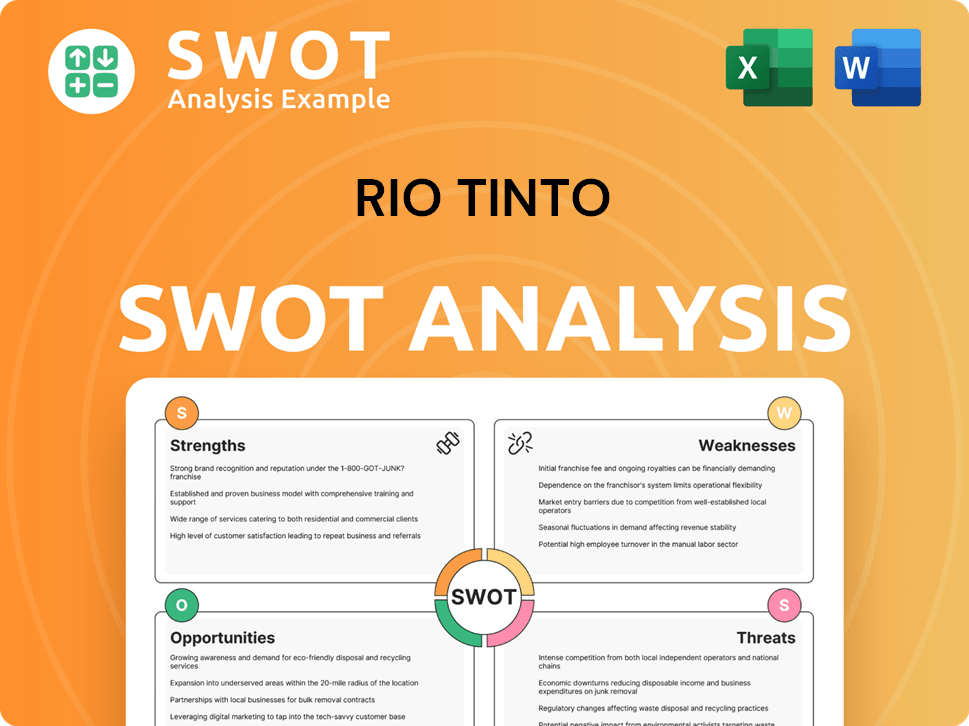
What Do Rio Tinto’s Customers Want?
Understanding the customer needs and preferences is crucial for the success of any business, and for the [Company Name], this involves a deep dive into its B2B customer base. The company's target market is primarily driven by the demand for essential raw materials, but also by the increasing need for sustainable and technologically advanced products.
The company's customer demographics are varied, encompassing industries such as aerospace, construction, and renewable energy. These customers' buying behaviors are significantly influenced by long-term supply contracts, product quality, and the ability to meet specific industry standards. The company's market analysis reveals a growing emphasis on environmental, social, and governance (ESG) factors.
The company actively engages with its customers to understand their evolving needs and preferences, using this information to inform product development and strategic decisions. This customer-centric approach allows the company to adapt to market trends and maintain a competitive edge in the mining industry. For a deeper understanding of the company's growth strategies, consider reading about the Growth Strategy of Rio Tinto.
The primary needs of the company's customers revolve around reliability, quality, and sustainability. The company addresses these needs through responsible sourcing, ESG traceability, and innovative solutions for decarbonization. The company's customer relationship management is crucial for understanding and meeting these evolving demands.
- Reliability and Quality: Customers require consistent access to high-quality materials that meet specific industrial standards.
- Sustainability: There's a growing demand for sustainably sourced and low-carbon materials, with a focus on ESG factors.
- Technological Innovation: Customers seek advanced solutions, such as specialized aluminum for the aerospace industry and materials for clean energy.
- Long-Term Contracts: Purchasing behaviors are influenced by long-term supply contracts, ensuring stable access to raw materials.
- ESG Traceability: The company provides ESG traceability data through initiatives like its START™ sustainability label, which now covers copper cathodes, metal powders, and salt.
Rio Tinto PESTLE Analysis
- Covers All 6 PESTLE Categories
- No Research Needed – Save Hours of Work
- Built by Experts, Trusted by Consultants
- Instant Download, Ready to Use
- 100% Editable, Fully Customizable
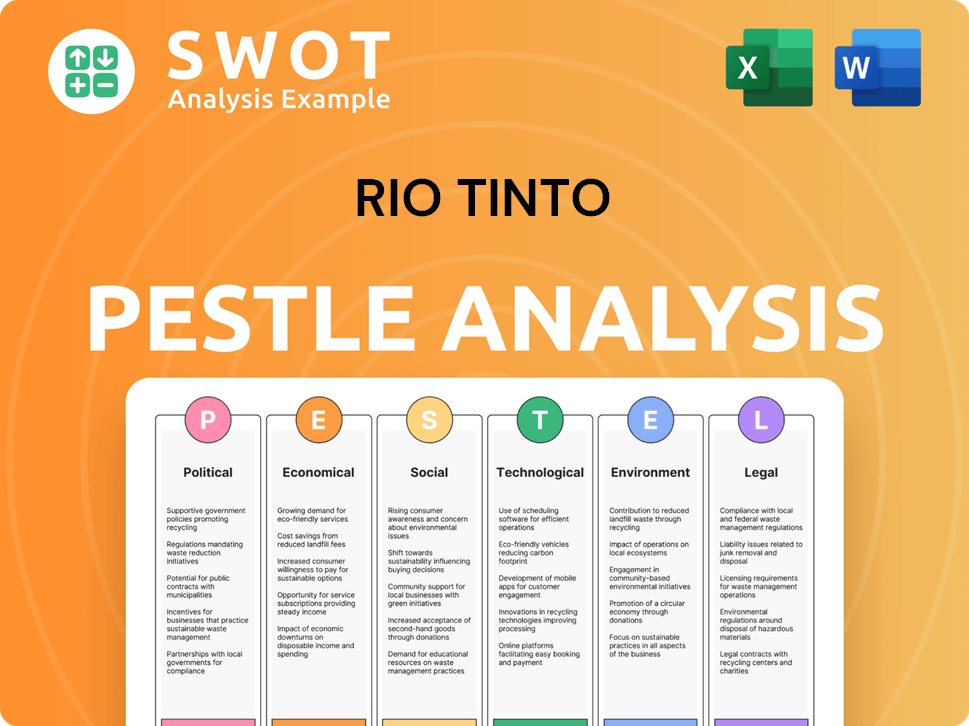
Where does Rio Tinto operate?
The geographical market presence of the company is extensive, spanning across 35 countries with 60 projects and a workforce of 52,000 employees. This wide reach is strategically designed to serve key industrial centers and growing economies. The company's approach is significantly influenced by the differences in customer demographics, preferences, and buying power across these regions. Understanding local preferences is crucial, especially in its largest market, Greater China.
In 2024, Greater China was the largest destination for its consolidated sales revenue, accounting for 57%. The United States followed with 17%, Japan with 7%, and Europe with 5%. The company also has a presence in other Asian countries (7%), Canada (3%), and Australia (2%). This distribution highlights the company's focus on major industrial economies and emerging markets.
The company's operations in Europe underscore its commitment to supporting regional competitiveness, particularly through the supply of high-grade iron ore and low-carbon materials like aluminum. Processing facilities in Iceland, Spain, and the Netherlands, along with an R&D facility in France, support decarbonization efforts. The company is actively exploring for 8 commodities in 17 countries, demonstrating its continuous search for new projects that support the energy transition.
The company's customer base is diverse, reflecting its global presence. It serves a wide range of industries, including construction, automotive, and manufacturing. The company's target market is influenced by regional economic conditions and industrial demands. For instance, the demand for iron ore in China is a significant factor.
Key customer segments include major steel producers, aluminum smelters, and other industrial consumers. These customers are located in regions with high industrial activity and infrastructure development. The company's customer segmentation strategy focuses on understanding the specific needs of each segment.
The company's geographic focus is on regions with high demand for its products, such as China, the US, and Europe. It adapts its strategies to align with the economic and regulatory environments of each region. This focus allows the company to optimize its market share and revenue streams.
Customer buying behavior is influenced by factors such as price, quality, and supply chain reliability. The company focuses on building strong relationships with its customers to understand their needs and provide tailored solutions. This approach helps in maintaining customer loyalty and securing long-term contracts.
The company's marketing strategy involves direct engagement with key customers and participation in industry events. It emphasizes the value of its products and services, focusing on sustainability and innovation. This strategy supports the company's efforts to maintain a competitive edge in the mining industry.
The company is exploring opportunities in emerging markets and focusing on expanding its product portfolio. This includes investments in new technologies and sustainable practices. The company's strategic initiatives aim to support its long-term growth and enhance its position in the global market, as discussed in Growth Strategy of Rio Tinto.
Rio Tinto Business Model Canvas
- Complete 9-Block Business Model Canvas
- Effortlessly Communicate Your Business Strategy
- Investor-Ready BMC Format
- 100% Editable and Customizable
- Clear and Structured Layout
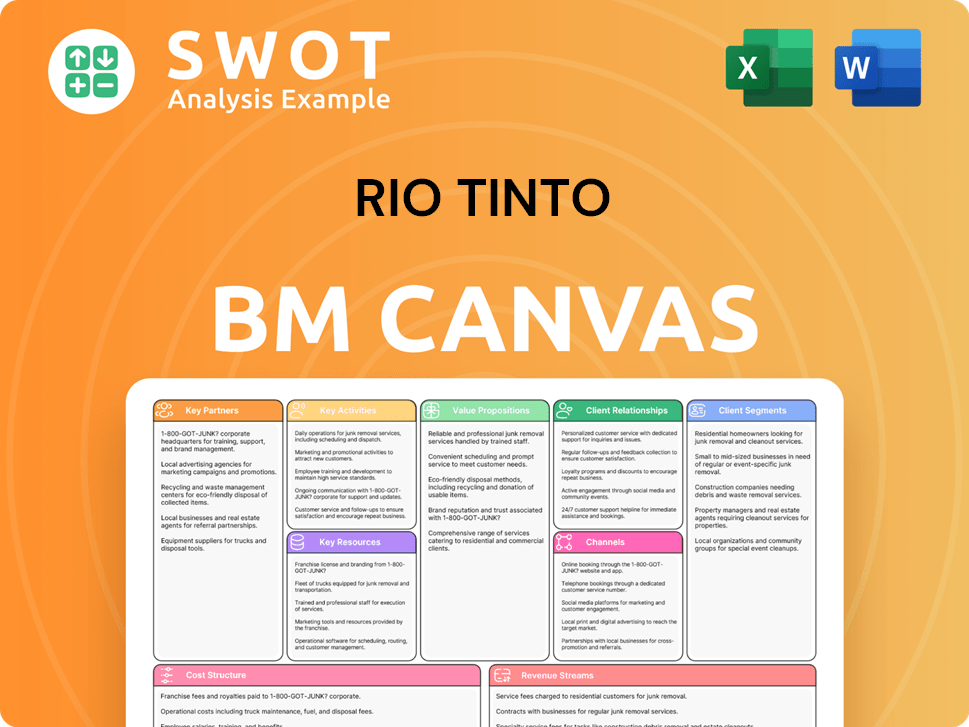
How Does Rio Tinto Win & Keep Customers?
Rio Tinto's customer acquisition and retention strategies are primarily business-to-business (B2B) focused, reflecting the nature of the mining industry. The company prioritizes building long-term relationships with its clients, emphasizing reliability, sustainability, and innovation. This approach is central to how Rio Tinto identifies its target market and engages with its customer base.
The company uses direct marketing, including telemarketing and direct mail, to reach specific audiences with personalized messages about its product offerings. Strategic partnerships are also crucial for both acquiring and retaining customers. A strong brand identity, focused on quality and responsible sourcing, is a key element in maintaining customer loyalty, ensuring consistent supply, and delivering solutions that address customer challenges, especially in areas like decarbonization.
To understand the financial aspects, explore the Revenue Streams & Business Model of Rio Tinto. This will provide insights into the company's financial strategies that support its customer-focused initiatives.
Rio Tinto uses direct marketing techniques, such as telemarketing and direct mail, to target specific segments of its customer base. These methods allow for personalized communication and detailed product presentations. This approach is a key part of their marketing strategy for target customers.
Strategic partnerships are vital for both acquiring and retaining customers. Recent examples include joint ventures and memorandums of understanding aimed at securing supply chains and expanding market reach. These partnerships help in market analysis.
Rio Tinto emphasizes sustainability in its marketing efforts, offering lower-carbon, responsibly sourced products. The START™ sustainability label provides ESG metrics, supporting customers' net-zero ambitions. This commitment is key for Rio Tinto's customer profile analysis.
Investment in technology and research and development (R&D) improves operational efficiency and safety. This indirectly enhances customer confidence and loyalty by ensuring a consistent and responsible supply of materials. This also supports Rio Tinto's customer relationship management.
Rio Tinto focuses on delivering high-quality products and ensuring supply security to retain customers. The company also provides solutions to customer challenges, particularly in decarbonization. The mining industry relies on these strategies.
- Quality Assurance: Ensuring the consistent quality of products is essential for maintaining customer satisfaction.
- Supply Chain Reliability: Guaranteeing a secure and dependable supply chain is crucial for building trust.
- Sustainability Focus: Offering sustainable and traceable products aligns with the increasing demand for responsible sourcing.
- Technological Innovation: Investing in R&D to improve efficiency and safety enhances customer confidence.
Rio Tinto Porter's Five Forces Analysis
- Covers All 5 Competitive Forces in Detail
- Structured for Consultants, Students, and Founders
- 100% Editable in Microsoft Word & Excel
- Instant Digital Download – Use Immediately
- Compatible with Mac & PC – Fully Unlocked
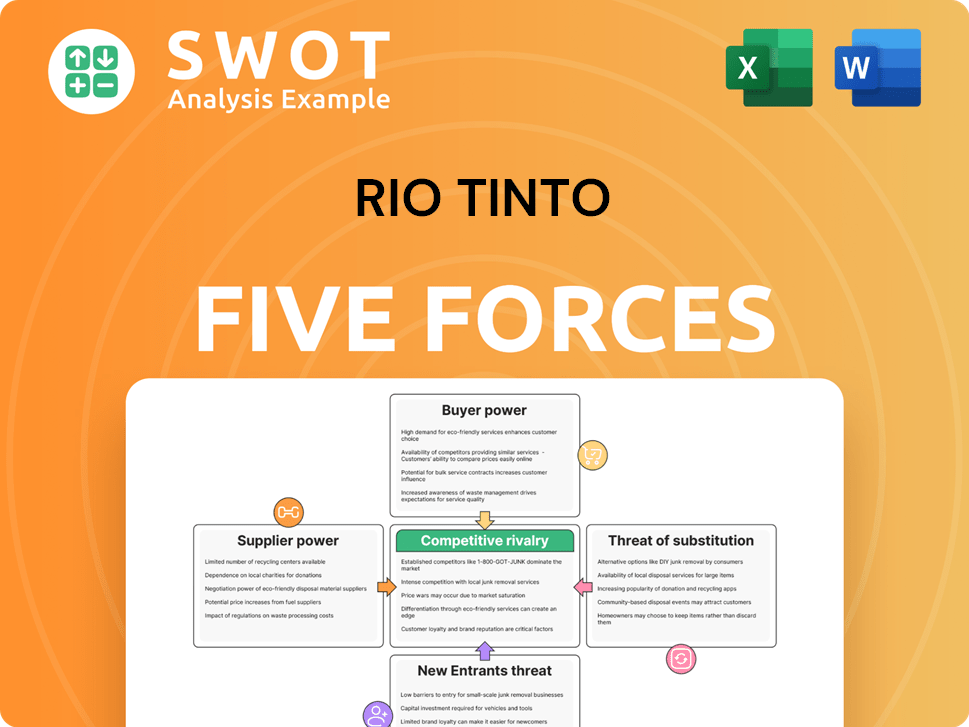
Related Blogs
- What are Mission Vision & Core Values of Rio Tinto Company?
- What is Competitive Landscape of Rio Tinto Company?
- What is Growth Strategy and Future Prospects of Rio Tinto Company?
- How Does Rio Tinto Company Work?
- What is Sales and Marketing Strategy of Rio Tinto Company?
- What is Brief History of Rio Tinto Company?
- Who Owns Rio Tinto Company?
Disclaimer
All information, articles, and product details provided on this website are for general informational and educational purposes only. We do not claim any ownership over, nor do we intend to infringe upon, any trademarks, copyrights, logos, brand names, or other intellectual property mentioned or depicted on this site. Such intellectual property remains the property of its respective owners, and any references here are made solely for identification or informational purposes, without implying any affiliation, endorsement, or partnership.
We make no representations or warranties, express or implied, regarding the accuracy, completeness, or suitability of any content or products presented. Nothing on this website should be construed as legal, tax, investment, financial, medical, or other professional advice. In addition, no part of this site—including articles or product references—constitutes a solicitation, recommendation, endorsement, advertisement, or offer to buy or sell any securities, franchises, or other financial instruments, particularly in jurisdictions where such activity would be unlawful.
All content is of a general nature and may not address the specific circumstances of any individual or entity. It is not a substitute for professional advice or services. Any actions you take based on the information provided here are strictly at your own risk. You accept full responsibility for any decisions or outcomes arising from your use of this website and agree to release us from any liability in connection with your use of, or reliance upon, the content or products found herein.